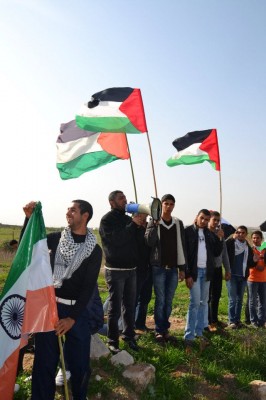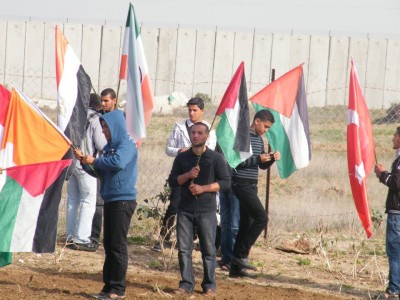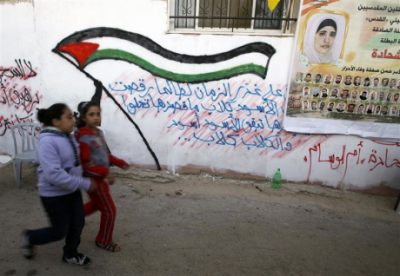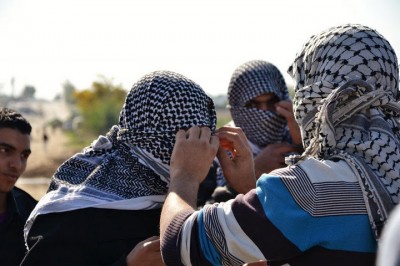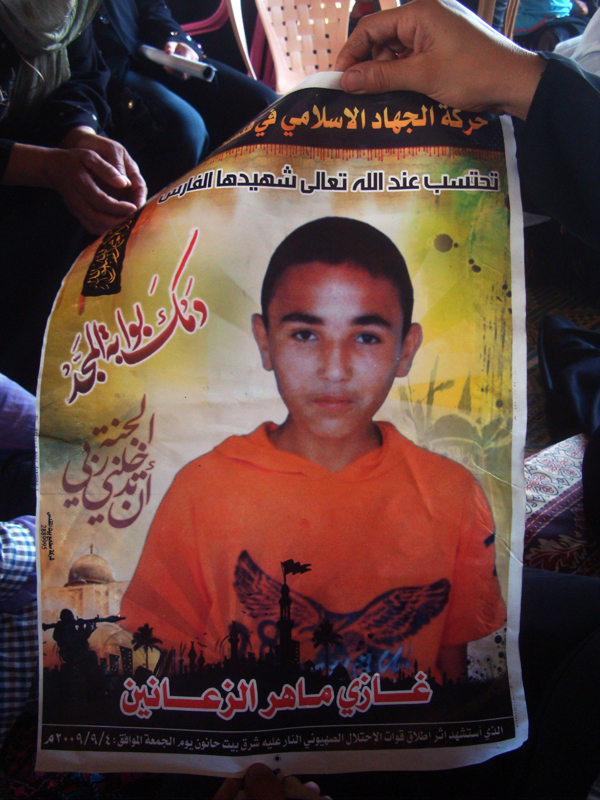by Rosa Schiano
13 December 2011 | il blog di Oliva

Nedal Khaleel Hamdan (Photo: Rosa Schiano, il blog di Oliva)
This morning at the Eretz border in Beit Hanoun, Israeli soldiers shot a 14-year-old boy, Nedal Khaleel Hamdan. We went to the hospital to meet him. We found him sitting on the bed with his left shoulder bandaged, surrounded by his family.
Nedal was collecting metal along with other boys in an area near the border. Often young people his age collect metal, then sell it to earn some money and help their families as well. At about 8:30 in the morning, Israeli soldiers started shooting at them; Nedal and the other fled, but while they were running Nedal was hit in the shoulder by a bullet.
He was transported on a cart to Balsam Hospital, which provided first aid, and was then transferred to Kamal Odwaan Hospital in Beit Hanoun. There the doctor told us: “We made an incision to remove the M-16 bullet. There is a total lack of supplies in the emergency room. We have to ration everything. People get a lot less medicine than they need. ”
Nadal’s recovery time will be a month. Fortunately, there have been no complications.
When we asked Nedal why he works there, told us: “We try to sell the metal to give our families the money they need to live.”
His father, Khaleel, has 16 children, and cannot work due to a problem in his legs. Lack of money forces his children to work in these dangerous areas, even if they do not earn more than 10 shekels for the sale of the metal. Sometimes his family depends on this money. Khaleel adds: “We live in a situation of injustice in Palestine and suffer from this occupation, but we want to work and need some way to make money. We hope that this occupation and the siege end soon and we can have a better life.”
How long can such crimes continue? Here they fire on children, while the world keeps its eyes and ears closed.
Updated on December 14, 2011
---------
13-12-2011
IOF Opens Fire at Rubble Collectors in Vicinity of Erez Crossing; One Child Injured
At approximately 7:15 am on Tuesday 13 December 2011, Israeli Occupation Forces (IOF) positioned in concrete watchtowers opened heavy fire on Palestinian civilians who were collecting scrap and rubble from a destroyed area in the vicinity of the Erez crossing. The civilians were about 450 meters away from the separation fence between the Gaza Strip and Israel when the IOF opened fire at them. As a result, Nedal Khalil Attiya Hamdan, 14, sustained a bullet wound in the left shoulder.
According to Al Mezan’s field investigations, Hamdan and his relatives were collecting scrap in the area. After Hamdan was injured he was carried on a donkey-drawn cart to Balsam Hospital, then referred to Kamal Odwan Hospital. Medical sources described his injury as moderate. Hamdan lives on Qarman street in Beit Hanoun.
----------
Voices from the Occupation: Nedal H. - Injuries
 Name:
Name: Nedal H.
Date of incident: 13 December 2011
Age: 13
Location: Erez industrial zone,
Gaza
Nature of incident: Shot while collectinig scrap metal
On 13 December 2011, a 13-year-old boy from Gaza is shot in the shoulder whilst collecting scrap metal, about 400 metres from the border with Israel.
Thirteen-year-old Nedal describes his family’s financial situation as “very harsh”. “I was very weak at school,” says Nedal, “and had to drop out last year after only finishing the fifth grade because I failed three times. I dropped out and tried to learn a trade to help me support my family and myself, but I failed.”
“Ahmad is my cousin and my best friend. He is like me, a drop-out. Everyday he collects scrap metal from Erez and earns 30 to 40 shekels, depending on how much he collects,” says Nedal. “I saw Ahmad yesterday evening, 12 December, and told him I would like to join him in collecting scrap metal from the industrial zone, and share the 15 shekel rent for the donkey cart. He told me to be ready the following morning at 7:30 am.”
The next morning the two boys set off to collect scrap metal from the industrial zone as agreed. “We approached Erez Crossing and got off the cart and started walking and looking for scrap metal, about 400 metres from the border fence,” recalls Nedal. “We were not alone. There were around 30 collectors my age. I also saw two Israeli observation towers on the border, but I did not see any soldiers inside.”
“We stopped the cart on the paved road and walked to the industrial zone to the west. Suddenly, shooting erupted from one of the observation towers. I was about 40 to 50 metres west of the paved road, and about 400 metres away from the border fence. The collectors started running because of it. I myself got scared. I turned around and started running away from the border, and headed back to the cart that was parked to the southeast. I kept running fast because the shooting was intensive,” says Nedal. “I ran about 10 metres when I felt something hitting me on the back of my left shoulder, and I felt my left arm had been paralyzed. I looked at it and saw my shoulder bleeding, and realised I had been injured by bullets from the observation towers.”
Another scrap metal collector carried Nedal to a nearby horse cart and he was transferred to Balsam Hospital, and then to Kamal Odwan Hospital. Doctors at the hospital operated to remove the bullet and told Nedal that he would be hospitalised for two to three days. “I will never go back to the industrial zone. I went there to collect scrap metal to help my family, and I got shot on the first day. It is a very dangerous thing to do, and I do not recommend it,” says Nedal. “As for Ahmad, I was told he went back to the industrial zone to get the donkey cart.”
13 December 2011


